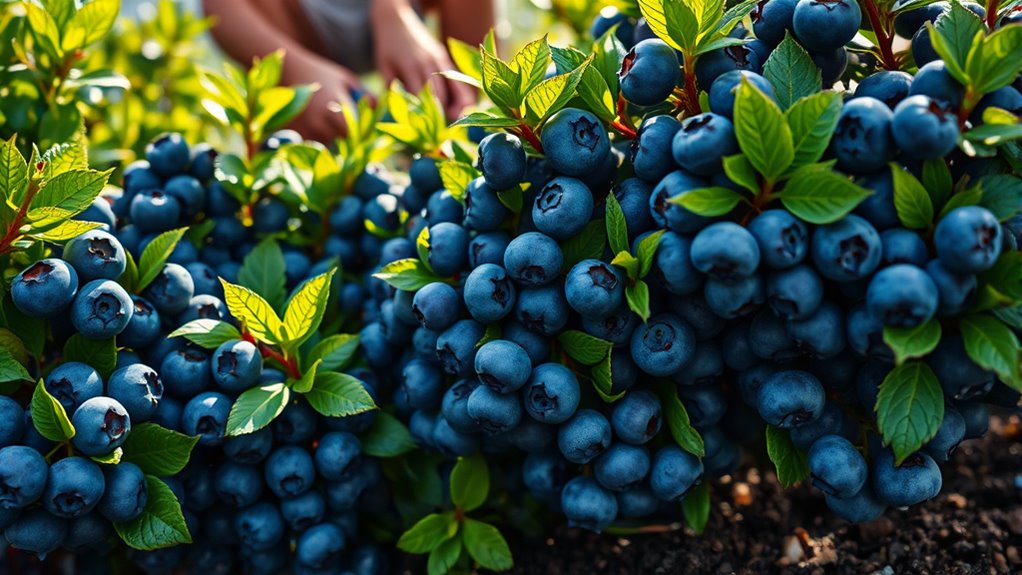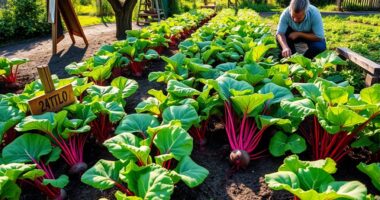If you’re looking to grow delicious blueberries, there are a few essential tips to follow. First, make sure your soil’s acidic, ideally between pH 4.5-5.5. Space your plants 4-5 feet apart to give them room to thrive. Water them regularly, providing 1-2 inches weekly. Don’t forget to prune annually to keep them healthy. Finally, use fertilizers designed for acid-loving plants in early spring. Stick around to discover even more strategies for fruitful blueberry cultivation!
Key Takeaways
- Ensure soil pH is between 4.5-5.5 by testing and amending with organic matter like peat moss for optimal growth.
- Space blueberry plants 4-5 feet apart to promote airflow, sunlight exposure, and reduce competition for nutrients.
- Water plants with 1-2 inches weekly, using well-draining soil and mulch to retain moisture and prevent root rot.
- Prune annually to encourage healthy growth, and fertilize in early spring with nitrogen-rich fertilizers to support new development.
- Monitor for pests and protect plants during winter to enhance survivability and ensure a fruitful harvest.
Blueberries Care Handbook: The Beginners Guide to Growing Blueberries

If you’re new to gardening and enthusiastic to grow your own delicious fruit, the “Blueberry Cultivation Tips” is perfect for you. To start, blueberries thrive in acidic soil with a pH of 4.5-5.5 and need full sun. I recommend planting them in early spring or fall, spacing each plant 4-5 feet apart for proper airflow. Consistent watering is key—aim for 1-2 inches weekly. Mulching helps retain moisture and control weeds. Don’t forget to prune annually to encourage healthy growth. By following these guidelines, you’ll set yourself up for a bountiful blueberry harvest that you can enjoy!
Best For: Beginners looking to grow their own blueberries in suitable garden conditions.
Pros:
- High Nutritional Value: Blueberries are rich in vitamins, antioxidants, and fiber.
- Low Maintenance: Once established, blueberry plants require minimal care and can thrive with basic gardening practices.
- Delicious Fresh Fruit: Homegrown blueberries offer superior taste compared to store-bought options.
Cons:
- Specific Soil Requirements: Blueberries require acidic soil, which may necessitate soil amendments for some gardeners.
- Pest Vulnerability: Blueberry plants can attract pests that may require regular monitoring and management.
- Time to Maturity: It may take a few years before blueberry plants produce a significant harvest.
Highbush Blueberry Fruit/Shrub Seeds (300 Seeds Per Packet)
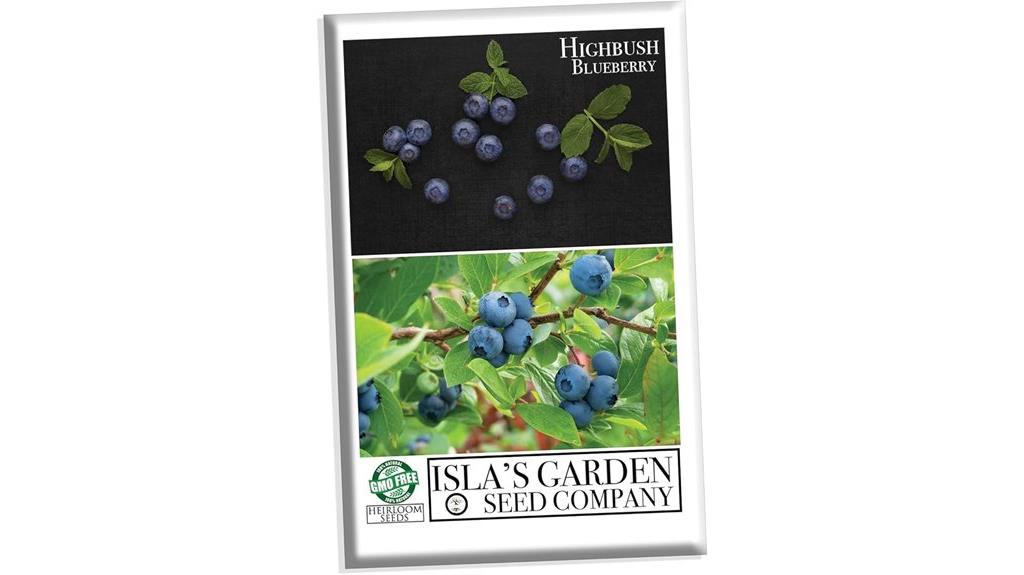
Highbush Blueberry Fruit/Shrub Seeds are an excellent choice for home gardeners looking to cultivate delicious blueberries. Each packet contains 300 seeds of the non-GMO Vaccinium corymbosum variety, thriving in USDA Zones 3-10. To get started, soak the seeds for 24 hours, then cold stratify them for 60 days. When you’re ready to germinate, surface sow them in sandy, well-drained soil, keeping it moist and shaded. With a germination rate of 70-80%, you’ll soon enjoy these beautiful blue fruits that bloom from May to July and ripen from August to September. Happy gardening!
Best For: Home gardeners looking to cultivate their own blueberries in a variety of climates.
Pros:
- Non-GMO seeds with a high germination rate of 70-80%.
- Hardy to USDA Zones 3-10, making them suitable for a wide range of environments.
- Produces delicious blueberries from May to September, ideal for fresh eating or preserves.
Cons:
- Some customers reported difficulties with seed germination despite following the provided instructions.
- Requires specific conditions such as cold stratification and sandy, well-drained soil for optimal growth.
- Average customer rating of 3.5 out of 5 stars indicates mixed feedback on overall satisfaction.
Blueberry Plant Emerald Live (4 Pack) for Edible Organic Garden

For those looking to cultivate a thriving edible organic garden, the Blueberry Plant Emerald Live (4 Pack) is an excellent choice. These premium-quality plants are robust and adaptable, perfect for both indoor and outdoor settings. With a delightful balance of sweetness and tartness, they yield abundant, plump berries. I love that they thrive in well-draining, acidic soil and require full sun exposure. Regular watering and seasonal fertilization keep them healthy. Plus, they bloom beautifully from spring to summer, ensuring a bountiful harvest. Just remember to protect them during winter and prune for ideal growth. You’ll enjoy delicious berries in no time!
Best For: Garden enthusiasts and beginners looking to grow sweet, plump blueberries in their edible organic garden.
Pros:
- Premium Quality: The plants are carefully selected for health and robustness, ensuring a strong start.
- High Yield: Known for producing abundant harvests of delicious berries, perfect for fresh eating or preserves.
- Versatile Growing: Suitable for both indoor and outdoor planting, adapting well to various climates.
Cons:
- Mixed Arrival Conditions: Some customers reported issues with plant condition upon arrival, affecting their initial growth.
- Survivability Concerns: A few plants did not survive after being planted, which may be a concern for new gardeners.
- Maintenance Required: Regular watering, fertilization, and pruning are necessary to achieve optimal growth and harvest.
Cultivating Blueberries: A guide to growing blueberries in pots
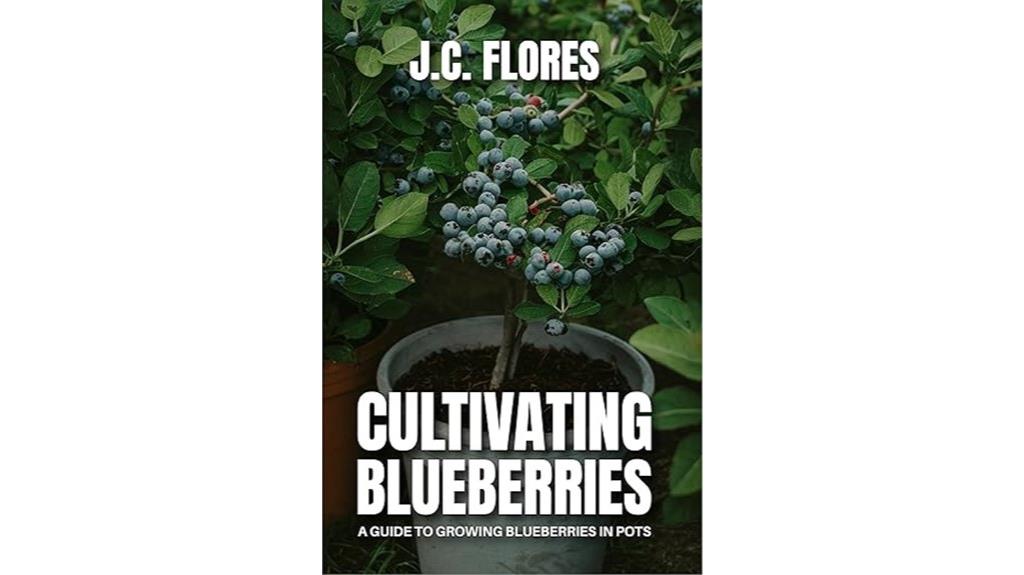
Growing blueberries in pots is an excellent option for those with limited space or poor soil conditions. I found “Cultivating Blueberries” to be incredibly helpful in my journey. This book covers everything you need to know about growing blueberries in containers, making it easy to understand the process. I was impressed by its reasonable price, especially given the practical insights it offers. Many readers, including myself, consider gifting it to friends who are interested in gardening. I discovered it through a Facebook group, and I can’t recommend it enough for anyone looking to enjoy homegrown blueberries!
Best For: Anyone looking to grow blueberries in pots, especially those with limited space or poor soil conditions.
Pros:
- Comprehensive Guide: Covers all necessary aspects of blueberry cultivation in containers.
- High Satisfaction: Readers express great satisfaction with the practical insights provided.
- Gift Worthy: Many consider it a valuable gift for gardening enthusiasts.
Cons:
- Limited to Blueberries: Focused solely on blueberries, which may not appeal to those interested in a wider range of gardening topics.
- Niche Audience: Primarily targets individuals interested in container gardening, potentially limiting its readership.
- Availability: May not be readily available in all bookstores, requiring online purchase.
The Berry Grower: Small Scale Organic Fruit Production in the 21st Century

If you’re looking to plunge into organic fruit production with a focus on blueberries, “Blueberry Cultivation Tips” is tailored for you. I found “The Berry Grower” an invaluable resource for small-scale growers. It dives deep into various fruit varieties, including intriguing options like currants and gooseberries. The practical strategies for maintaining healthy plants gave me confidence in my cultivation efforts. Plus, the regional considerations help me choose the right fruits for my climate. While it could expand on winter prep for strawberries, it’s a must-read for anyone wanting to thrive in today’s organic farming landscape.
Best For: Those interested in small-scale organic fruit production and looking to diversify their crops with practical growing strategies.
Pros:
- Offers in-depth information on a variety of fruit options, including lesser-known varieties.
- Provides practical strategies for maintaining healthy plants, boosting growers’ confidence.
- Addresses regional considerations, helping growers choose fruits suitable for their specific climates.
Cons:
- Some topics, like winter preparation for strawberries, could use more detail.
- Lacks in-depth coverage of no-till practices, requiring readers to seek additional resources.
- May not cover every fruit variety comprehensively, limiting information for some growers.
Factors to Consider When Choosing Blueberry Cultivation
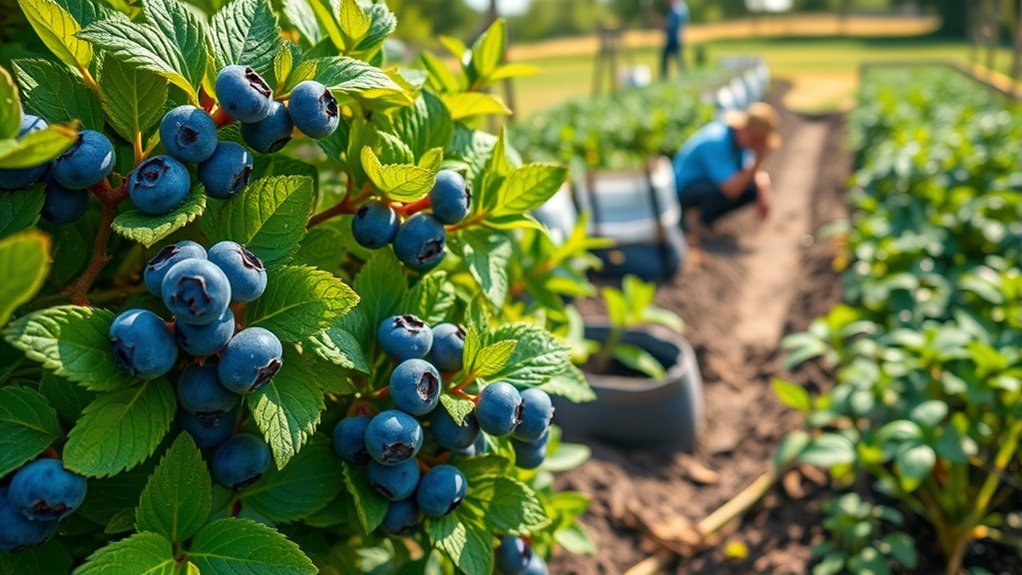
When I think about starting blueberry cultivation, I always consider several key factors. Soil acidity, sunlight exposure, and proper watering are essential for healthy plants. Plus, I can’t overlook the importance of spacing and fertilization to maximize my harvest.
Soil Acidity Requirements
Acidic soil is essential for successful blueberry cultivation. I’ve learned that blueberries thrive in soil with a pH range of 4.5 to 5.5. This acidity is vital for their nutrient absorption and overall health. If the soil is too alkaline, it can lead to nutrient deficiencies, especially in iron, which stunts growth and reduces yields. Before planting, I always conduct a soil test to check the pH level and determine what amendments are needed. Adding organic matter like peat moss or pine bark helps lower the pH and enhances drainage, both of which blueberries love. Plus, I make it a point to regularly monitor soil acidity, as it can change over time due to rainfall and fertilization practices.
Sunlight Exposure Needs
After ensuring your soil meets the right acidity levels, the next key factor in successful blueberry cultivation is sunlight exposure. Blueberries thrive in full sun, so I aim for at least 6-8 hours of direct sunlight each day. If they don’t get enough light, I’ve noticed poor fruit production and weak plants. That’s why I always select a planting spot with ample sunlight. I’ve found that morning sun is especially beneficial, as it dries dew on the leaves and minimizes the risk of fungal diseases. Additionally, I avoid shaded areas created by taller trees or structures. In hotter regions, I consider partial shade during peak heat to protect my blueberries from sunburn while still ensuring they receive enough light.
Watering and Drainage
Consistent watering and proper drainage are essential for thriving blueberry plants. I aim for 1-2 inches of water each week, particularly during dry spells, to support their healthy growth and fruit production. It’s vital to use well-draining soil since blueberries are prone to root rot if moisture lingers too long. I’ve found that mulching around the plants helps retain soil moisture, suppress weeds, and improves soil structure over time. Regularly checking soil moisture levels is key; overwatering can hinder growth and yield. Plus, blueberries thrive best in acidic soils with a pH of 4.5-5.5, often found in well-drained sandy soils. Keeping these factors in mind will help guarantee a bountiful harvest.
Plant Spacing Guidelines
When planning your blueberry garden, I recommend spacing your plants 4-5 feet apart. This distance guarantees proper air circulation, which helps reduce the risk of disease. Adequate spacing promotes healthy growth and maximizes sunlight exposure for each plant. If you plant too closely together, your blueberries will compete for nutrients and water, leading to lower berry production and overall plant health. Proper spacing also makes maintenance tasks like pruning, watering, and harvesting much easier. For highbush varieties, this spacing is especially significant, as they can grow up to 6 feet tall and wide. By following these guidelines, you’ll set your blueberry plants up for a bountiful harvest. Happy gardening!
Fertilization Strategies
To guarantee your blueberries thrive, understanding fertilization strategies is essential. I’ve found that fertilizers high in nitrogen, specifically designed for acid-loving plants, are the best choice to support their growth and fruit production. Timing is key, so I fertilize in early spring when new growth begins, ensuring nutrients are available during the significant growing season. It’s important to avoid over-fertilizing, as excess nutrients can harm the plants and lead to poor fruit production. I also monitor soil pH, aiming for a range of 4.5 to 5.5, which is fundamental for nutrient absorption. Regular soil testing helps me determine nutrient needs, guiding my fertilization practices and enhancing overall plant health and yield.
Pest and Disease Management
While cultivating blueberries, managing pests and diseases is essential for ensuring a healthy crop and maximizing yield. I regularly monitor for common pests like aphids, spider mites, and fruit flies to protect my plants. When infestations occur, I prefer using organic pest control methods such as insecticidal soap or neem oil to minimize chemical exposure. I also pay close attention to diseases like powdery mildew and root rot; keeping good air circulation and avoiding overwatering are critical steps. I space my plants about 4-5 feet apart, which not only aids in air circulation but also reduces disease spread. Early detection and treatment of any issues are important, so I conduct routine inspections throughout the growing season.
Frequently Asked Questions
How Long Does It Take for Blueberry Plants to Bear Fruit?
When I started growing blueberry plants, I was enthusiastic to see fruit. Generally, it takes about two to three years for blueberry plants to bear fruit after planting. However, if you choose established plants, you might enjoy a harvest sooner. I found that patience is key, as providing the right conditions, like soil quality and sunlight, can make a big difference in how quickly my plants started producing those delicious berries.
Can Blueberries Be Grown in Shaded Areas?
I’ve often wondered about the best conditions for growing blueberries. While they thrive in full sun, I’ve found that they can tolerate partial shade. However, they won’t produce as much fruit. If I choose to plant them in shaded areas, I make sure the shade isn’t too dense and monitor their growth closely. Ultimately, they’ll need some sunlight to flourish, so balancing shade and light is key to a decent harvest.
What Pests Commonly Affect Blueberry Plants?
When I grow blueberries, I’m always on the lookout for pests that might affect my plants. Common culprits include aphids, spider mites, and fruit flies. I’ve noticed that these pests can damage leaves and fruit if not managed properly. I usually check my plants regularly and take action early, whether that means using insecticidal soap or introducing beneficial insects. Staying vigilant helps me protect my blueberry harvest from these pesky invaders!
How Often Should I Prune My Blueberry Bushes?
You’d think pruning blueberry bushes would be a challenging task, but it’s actually quite liberating! I’ve found that pruning once a year, preferably in late winter or early spring, keeps my bushes healthy and productive. Removing dead or weak branches encourages new growth, and I actually enjoy seeing the transformation. Trust me, a little pruning goes a long way in ensuring a bountiful harvest. Don’t underestimate the power of those snips!
What Is the Ideal Soil Ph for Blueberries?
When I think about growing blueberries, I always check the soil pH first. Ideally, blueberries thrive in acidic soil, with a pH between 4.5 and 5.5. I’ve found that testing my soil regularly helps me maintain the right balance. If it’s too high, I add sulfur or organic matter to lower it. By keeping an eye on the pH, I guarantee my blueberry bushes stay healthy and produce a bountiful harvest.
Conclusion
In the end, growing blueberries is like nurturing a friendship—requiring patience, care, and the right conditions to flourish. By following these tips, you’ll be well on your way to a bountiful harvest that bursts with flavor and color. Remember, every berry you pick is a reward for your hard work, a sweet reminder of the journey. So dig in, and let your garden transform into a vibrant oasis of blue!
